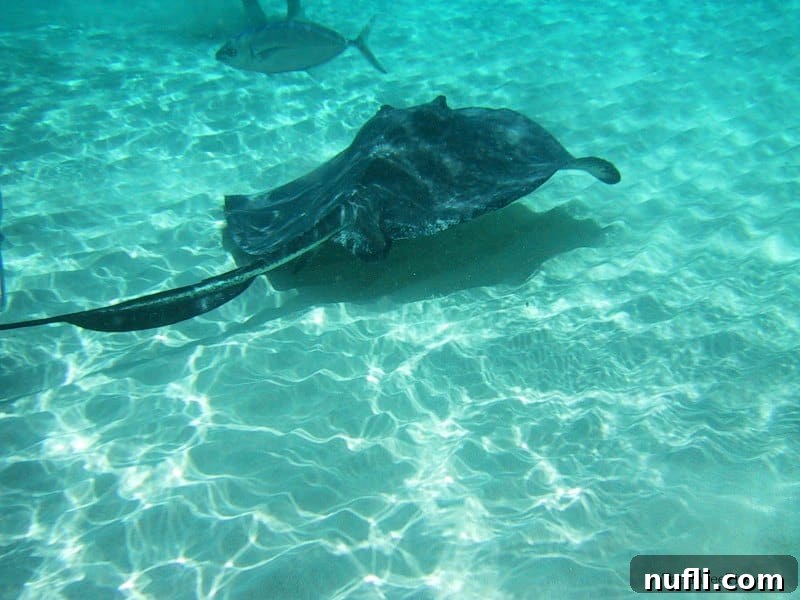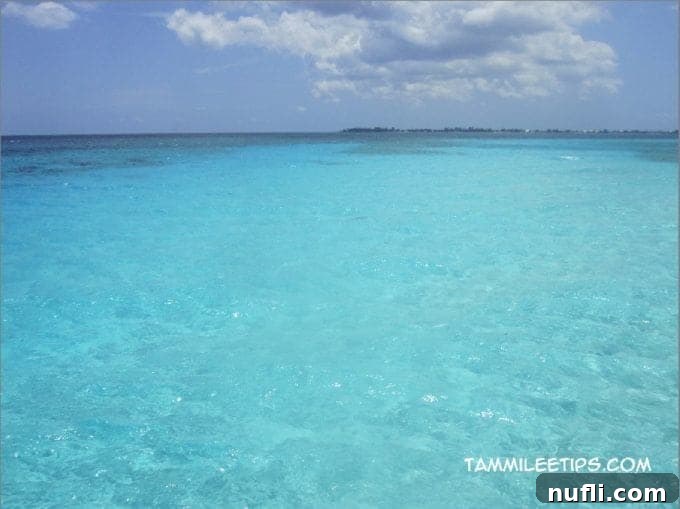Welcome to Grand Cayman, a jewel nestled in the azure embrace of the Western Caribbean, where sun-kissed beaches meet vibrant marine life and a sophisticated island charm. Far more than just a tropical getaway, Grand Cayman offers an unparalleled blend of natural beauty, adventurous excursions, and world-class amenities, catering to every traveler’s desire. Imagine yourself gliding through crystal-clear waters alongside graceful stingrays, savoring a refreshing cocktail with your toes in the sand at the iconic Rum Point, or simply unwinding on the legendary Seven Mile Beach, frequently lauded as one of the world’s finest. But the allure doesn’t stop there; this island paradise also boasts an impressive array of shopping opportunities, from charming local craft markets brimming with unique souvenirs to high-end boutiques offering duty-free luxury goods and exquisite jewelry.
Grand Cayman isn’t just a destination; it’s an experience waiting to unfold, promising unforgettable moments whether you’re seeking exhilarating adventures, serene relaxation, or a taste of sophisticated island life. Its inviting atmosphere and diverse attractions make it a top choice for families, couples, and solo travelers alike, all year round.

Unveiling Grand Cayman: Your Essential Travel Guide
Where is Grand Cayman Located?
Grand Cayman forms the largest of the three Cayman Islands, strategically positioned in the Western Caribbean. This prime location places it approximately 150 miles south of Cuba, about 460 miles south of Miami, Florida, and 167 miles northwest of Jamaica. Its central Caribbean location makes it an accessible and popular stop for many cruise lines and a favored destination for those seeking a tropical escape with convenient flight connections from North America.
How Many Islands Make Up the Cayman Islands?
The Cayman Islands archipelago comprises three distinct islands, each offering its own unique charm and attractions. These include the bustling and most developed Grand Cayman, the rugged and adventurous Cayman Brac, and the tranquil, pristine Little Cayman. While Grand Cayman is the hub of activity and home to the majority of the population and tourist infrastructure, Cayman Brac and Little Cayman offer secluded retreats for divers, nature enthusiasts, and those seeking a more off-the-beaten-path experience. Together, these islands create a diverse Caribbean destination, promising something for every type of traveler.
Top Things to Do in Grand Cayman: An Explorer’s Guide
Grand Cayman truly offers an abundance of activities, ensuring that every day can be a new adventure or a perfect day of relaxation. Here’s a deeper dive into the island’s most captivating experiences:
- Experience Stingray City: No visit to Grand Cayman is complete without an unforgettable excursion to Stingray City. This unique natural sandbar is home to a community of friendly southern stingrays that readily interact with visitors in their natural habitat. Wade into waist-deep water or snorkel among these gentle creatures, feeding them by hand and even receiving a “seven-years-good-luck” kiss! It’s a magical encounter that leaves a lasting impression and is perfectly safe under the guidance of experienced tour operators.
- Relax on Seven Mile Beach: Renowned globally for its powdery white sands and astonishingly clear turquoise waters, Seven Mile Beach is the quintessential Caribbean postcard come to life. Stretching for nearly six miles (not quite seven, despite its name), this crescent-shaped beach is ideal for sunbathing, swimming, and leisurely strolls. Many of the island’s premier resorts, restaurants, and watersports centers line its shores, offering everything from paddleboarding and jet-skiing to snorkeling opportunities directly from the beach.
- Discover the Charm of Rum Point: On the quieter, north side of the island, Rum Point offers a distinctly laid-back atmosphere, a refreshing contrast to the livelier Seven Mile Beach. This picturesque beach is famous for its iconic Wreck Bar & Grill, vibrant picnic tables nestled under swaying casuarina trees, and shallow, calm waters perfect for families. Enjoy a delicious lunch, sip on a Mudslide (the local specialty), and soak in the serene beauty. At night, Rum Point is also a popular departure point for spectacular bioluminescent bay tours, where microscopic organisms light up the water with every movement.
- Send a Postcard from Hell: Venture inland to the whimsical town of Hell, named for its unusual black limestone formations that resemble a fiery, desolate landscape. This quirky attraction offers a unique photo opportunity and the chance to send a postcard from the “Hell Post Office” to friends and family, boasting that you’re “having a hell of a good time” in Grand Cayman. It’s a fun, quick stop that adds a touch of humor to your island exploration.
- Indulge in Grand Cayman’s Famous Rum Cake: A culinary delight not to be missed, the Tortuga Rum Cake is a beloved souvenir and a delicious treat. These moist, rich cakes, infused with genuine Caymanian rum, are available in various flavors and sizes. Many bakeries and duty-free shops across the island offer samples, inviting you to take a taste of Grand Cayman home with you.
- Explore Camana Bay: This vibrant, master-planned community offers a sophisticated blend of shopping, dining, and entertainment. With its waterfront promenades, diverse boutiques, acclaimed restaurants, and an active calendar of events, Camana Bay is a modern hub where locals and visitors gather. Enjoy fine dining, catch a movie, or simply stroll through its beautifully landscaped public spaces.
- Dive into a World-Class Underwater Wonderland: Grand Cayman is consistently ranked among the top diving destinations globally. Its remarkably clear waters, vibrant coral reefs, dramatic wall dives, and numerous shipwrecks (including the famous USS Kittiwake) attract divers of all levels. From shallow snorkeling spots teeming with colorful fish to challenging deep dives, the island’s marine ecosystem is a breathtaking spectacle. Numerous dive operators offer certification courses, guided tours, and equipment rentals.
- Visit the Queen Elizabeth II Botanic Park: Home to the critically endangered Blue Iguana, this sprawling park is a sanctuary for native flora and fauna. Explore various themed gardens, including the Heritage Garden, Floral Garden, and the Orchid Garden, and take a guided tour to learn about the fascinating Blue Iguana Conservation program. It’s a peaceful escape and a vital conservation effort.
- Discover the Crystal Caves: Journey into the heart of Grand Cayman to explore its impressive Crystal Caves. These ancient geological formations feature stunning stalactites, stalagmites, and crystal structures, offering a fascinating glimpse into the island’s natural history. Guided tours provide insightful commentary about the caves’ formation and their unique ecosystems.
Essential Grand Cayman Travel Tips
To ensure a smooth and enjoyable trip, keep these practical tips in mind:
- Currency Matters: While the official currency is the Cayman Islands Dollar (CI$), the U.S. Dollar (US$) is widely accepted throughout Grand Cayman. However, it’s crucial to always check whether prices are listed in CI$ or US$ to avoid confusion. The exchange rate is fixed at approximately 1 CI$ = 1.25 US$, or 1 US$ = 0.80 CI$. Many businesses will provide change in CI$, so it’s helpful to be aware of the conversion.
- What to Pack: Given its tropical climate, light, breathable clothing is essential. Don’t forget swimwear, sunscreen (reef-safe varieties are encouraged), insect repellent, a wide-brimmed hat, and comfortable walking shoes. For evenings, smart casual attire is generally appropriate for dining out.
- Getting Around: Taxis are readily available at the airport and major tourist areas. Rental cars offer flexibility for exploring, especially if you plan to venture beyond Seven Mile Beach. Remember that driving is on the left-hand side of the road in the Cayman Islands. Public minibuses also operate along major routes, offering an affordable way to travel.
- Best Time to Visit: The peak tourist season runs from December to April, characterized by cooler temperatures, lower humidity, and less rainfall, making it ideal for outdoor activities. The off-peak season (May to November) sees warmer temperatures, higher humidity, and the possibility of tropical storms or hurricanes, but also offers lower prices and fewer crowds.
- Entry Requirements: Visitors typically need a valid passport that is valid for at least six months beyond their intended departure date. Always check the latest entry requirements for your nationality before traveling.
- Safety: Grand Cayman is a very safe destination with low crime rates. However, as with any travel, it’s wise to take standard precautions, such as safeguarding your valuables and being aware of your surroundings.
Souvenirs and Shopping: What to Buy in Grand Cayman
Grand Cayman offers a fantastic shopping experience, whether you’re looking for a small memento or a luxurious keepsake. Beyond the duty-free jewelry and high-end fashion, here are some local favorites:
- Local Art and Crafts: Discover unique handcrafted items, including replicas of pirates, intricate shell art, and carvings of the Cayman’s beloved mascot, Sir Turtle. These items make for authentic and charming souvenirs.
- Blue Iguana Merchandise: Support local conservation efforts by purchasing items featuring the iconic Blue Iguana, often found in local shops and at the Botanic Park.
- Cayman Gold Rum & Spirits: Sample and purchase locally produced rum, a perfect embodiment of the Caribbean spirit. The famous Tortuga Rum Cakes are also a must-buy!
- Duty-Free Goods: George Town offers a wide array of duty-free shops selling luxury watches, jewelry, perfumes, and designer clothing, often at attractive prices.
Intriguing Random Facts About Grand Cayman
Delve into some lesser-known facts that make Grand Cayman truly unique:
- A Tender Port for Cruise Ships: For many cruise lines, Grand Cayman operates as a tender port. This means that cruise ships anchor offshore, and passengers are ferried to the main dock in George Town via smaller boats called tenders. This process adds a unique element to the arrival experience.
- Home to the Magnificent Blue Iguana: The critically endangered Grand Cayman Blue Iguana (Cyclura lewisi) is native only to Grand Cayman. These magnificent reptiles can grow to be up to five feet long and are the largest native land animal on the island. Significant conservation efforts, primarily at the Queen Elizabeth II Botanic Park, are helping to bring them back from the brink of extinction.
- Grand Cayman Parrots Thrive: The island is home to a thriving population of the endemic Grand Cayman Parrot (Amazona leucocephala caymanensis). Around 4,000 of these vibrant, chatty birds can be found across the island, particularly in more forested areas, adding a splash of color and sound to the natural landscape.
- A Global Financial Hub: Beyond tourism, Grand Cayman is also recognized as a significant offshore financial center, attracting international businesses and contributing to the island’s sophisticated infrastructure and services.
We hope these insights enhance your anticipation for a trip to Grand Cayman. If you have any personal Grand Cayman travel tips or favorite spots, we would love for you to share them by commenting on this post. Your contributions help us create an even more comprehensive guide for future visitors!
Further Caribbean Adventures and Resources
For those planning a broader Caribbean exploration, here are some additional resources to inspire your journey:
- Discover Mahogany Bay, Roatan
- Essential Caribbean Cruise Travel Tips
- Tips for Visiting Maho Beach, Saint Maarten
- The Best Things to Do in Curacao on a Cruise
- Experience Palm Island, Aruba
- Explore all of our comprehensive Caribbean travel articles.
